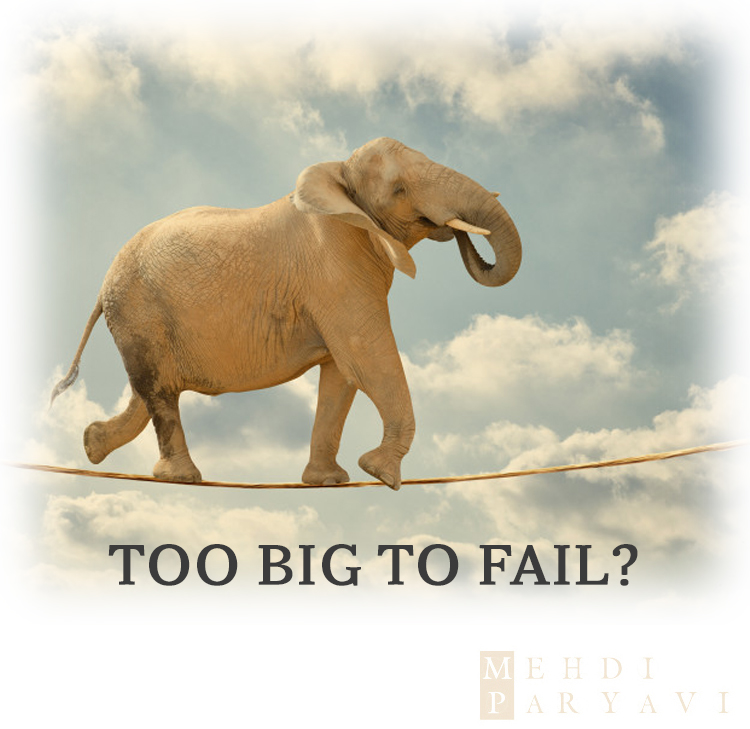DATACENTER
Too Big to Fail?
JUNE 27, 2017 / BY MEHDI PARYAVI

Amazon, Microsoft, Google Clouds – Good or Bad?
The publication of this blog coincides with the Independence Day. Though this junction was not intended with strong emphasis, nevertheless the following should provide an aspirational insight for us to always maintain a certain level of independence on the global stage for both our businesses and our government…
While larger organizations move into hyper-scale environments, these days, most businesses do not build their own data centers anymore. This trend represents the notion that the biggest providers such as Amazon, Microsoft, IBM and Google are becoming the default options of choice. Question is, are we unknowingly, by embracing these seemingly default choices, limiting our own options? Is the embodiment of this trend, a noble inclination?
Generally speaking about trends, our philosophy is that no trend is a good trend, when the trend itself becomes the goal, instead of serving as a calculated mean to achieve the actual target. That’s when we start losing sight of our core intentions and the underlying reasons for the emergence of what we now consider our goal. It is a fact that with every trend, there comes a baggage of business/marketing agenda that tends to dilute the true essence and purpose of the trend itself. Trends come to life out of existing gaps and the thirst to innovate. However, the trends themselves become bottlenecks to novelty when they become our idles. This takes all the innovation away and delays the technological evolution.
No trend is a good trend, when the trend itself becomes the goal.
The subject occurrence has happened numerously in the world of information technology. For example, an old concept introduced decades ago, which we lost sight of for many years, got reintroduced to us again via a different label: virtualization. All of a sudden, after decades of delay, it is everyone’s hot-topic again and we somehow think it’s some brilliantly devised new invention, rather than a delayed evolution of the original novel.
Question 1. Should we outsource our Cloud? It depends.
Cloud is a good thing, no doubt. We are the biggest proponents of it. But the question is, what kind of Cloud is the right solution for us, our companies, or our governments, etc.? Moreover, hypothetically speaking, how much of this “Cloud” can we outsource?
It is the nature of science to learn by observation and experience: trial and error.
To shed light into the perspective of where these key questions take us, let’s render a non-IT/non-Cloud example:
We lost the skillsets, the agility, as well as the will to produce and manufacture many products and components when we outsourced most of our production to certain other (“more cost-effective”) countries. Our dependence on such countries will remain costly till eternity. Furthermore, our national resilience will remain at the custody of those nations until and unless we reverse and pay for the reversal of our past decisions. Thus, until further notice, our decisions and the associated costs of such decisions, will be directly impacted by the strategic dependence we chose to have on the outside world.

Now in the manufacturing world, after paying hefty recovery costs, building skillful labor, reinstating factories, etc. it a feasible and commendable possibility to bring manufacturing back home. However, in the ever-transforming world of information technology, reversing such decisions prove extremely costly and render slim feasibilities. When we outsource our infrastructure to any 3rd party, specially the big players, we are saying farewell to our own infrastructure resourcefulness and independence for the life of our enterprise. This is a fact. We are also betting that “they” will do a better job than we do with our data management.
When we outsource our infrastructure to any 3rd party, specially the big players, we are saying farewell to our own infrastructure resourcefulness and independence for the life of our enterprise.
Yes, nobody can be totally independent. Correct, it’s all about efficiency and focusing on one’s business rather than getting into complex operations that can possibly be done better by outsourced providers. But, once you migrate your application over to a given cloud provider, migrating to another provider or bringing some of the infrastructure back home to the enterprise is not as simple as a manufacturing plant who can, easily shop around and switch between suppliers of its raw materials. Technology always does have its complexities when it comes to providers, especially cloud providers. Therefore it’s undoubtedly different from outsourcing raw materials for traditional production.
Question 2. What is Cloud anyway? Something you need to understand.
So, with everyone talking about it these days, what is Cloud anyway? Many people don’t even have a non-contradictory comprehension of its merits, pros and cons. Meanwhile, going Cloud is the goal for many institutions, not using Cloud as a mean to achieve certain business results. It gets even worse, when the goal is not only going to the Cloud, rather migrating to a specific provider’s cloud. One could ask, why not your own private cloud? Why not a hybrid solution? Why so much emphasis on a specific provider? If you have your reasons, don’t let us stop you because you are probably on track. But if you are migrating to somebody’s Cloud because you see everyone else is doing so, or you read a couple of articles on how great a given cloud is for others, think again. The same might not be true for you. Go back and do “your study”. What makes migrating to a 3rd party’s cloud a feasible choice for you, is the business optimization processes that makes it so within your organization. The solution to your Cloud questions can be found inside your organization and from within, not the vendor’s brochure. It is your business needs that can make a particular Cloud decision good or bad, success or failure, short-term or long-term.
The solution to your Cloud questions can be found inside your organization and from within, not the vendor’s brochure.
Question 3. Can Google, Amazon and Microsoft fail? Yes, they can.
Can Google fail? Can Amazon fail? Can Microsoft fail? Maybe the question can be answered by asking another: Is failure directly correlated with the size and might of an enterprise? Can anyone become too big to fail? Or, is it just a matter of time? Will these big companies make mistakes? Of course they will. Making mistakes and failing is what matures their offerings and optimizes their performance. Are live threats standing by to capitalize on those mistakes and exploit those vulnerabilities as vantage points? You bet there are. It is the nature of science to learn by observation and experience: trial and error. Note that there is only so much your provider can predict and devise ahead of time to fully preserve and protect your data and application. This spirit becomes more intrinsically embedded in everything we do as the nature of much of Cloud work is pushed by a massive profit agenda of keeping up with the consumer demand and company’s plans for expansion of apps, features, and offerings. In these seemingly good times, margin of error just goes up to the roof as the core of the scientific work and progress is not centered around maintaining health anymore, rather expanding prospects!
It is the nature of science to learn by observation and experience: trial and error.
Companies must have a holistic understanding of their own Application Ecosystem™ and identify the fine line between where and what it is that they want to outsource. Governments should really think twice before using public cloud services as a matter of preserving and ensuring national security. By the same token, they must ensure that they operate on a calculated series of resilient, secure, and robust clouds of their own to be able to warrant and preserve national security and prevent large-scale catastrophes.
Question 4. What is the impact of their failure? Too much.
Do we possess studies that measure, even with distant proximity, the true social, economical and political impacts of a big digital failure? More specifically, what is the impact to our economy if the big providers failed today? Are they too big to fail or, too soon to bail? Can the government even bail them out if they do fail, just like it bailed the banks or the auto industry? Bailing a bank financially is one thing, recovering lost data and rectifying compromised information is another. If the entire world migrated to Amazon, Microsoft, Google, and the like, then the target of a potential disruption would be only a handful of companies instead of millions of businesses. Can the concept of loss even be comprehended for such scenarios? Can the measure of such loss be numerically displayed?
Millions of businesses, hundreds of millions of people paralyzed with failures of just a couple of companies is a notion that has not been put to test before in the history of mankind.
Millions of businesses, hundreds of millions of people paralyzed with failures of just a couple of companies is a notion that has not been put to test before in the history of mankind. Yet, we travel the path as if those companies are just too big to fail. Are these companies made up of people smarter than the people they host? Can their riches protect them one hundred percent from the ever-growing threats? Are these enterprises free from inevitable decline, which is the consistent and fierce faith of any empire throughout history? Will these providers then become the pinnacle of a single-point-of-failure architecture across our Application Ecosystem™ stack?
Question 5. So what do we do? Do the right thing.
Study your own business. Know your own applications. Calculate each and every decision across your Application Ecosystem™ knowing that what might be the perfect solution for one company might render the total opposite for you.
Are we suggesting that migrating to AWS, Azure, etc. is a mistake and everyone should design, build and operate all their infrastructure in-house? No, we are not. Our suggestion is simple: while Amazon, Google, Microsoft maintain/grow their dominance and serve as effective remedies for on-demand and dynamically scaled application delivery, companies and governments should not consider them the exclusive and eternal choice for their application delivery.
While Amazon, Google, Microsoft maintain/grow their dominance and serve as effective remedies for on-demand and dynamically scaled application delivery, companies and governments should not consider them the exclusive and eternal choice for their application delivery.
If your economy does not warrant you the resilience, capacity and the reach to build your own topology, go for 3rd party cloud providers. If you do go for cloud providers, your business should then become focused on implementing resilience across multiple providers as apposed to your own data center nodes. Make sure that whatever you do, do not give one hundred percent of your cloud operation away. Keep a little bit of knowhow, infrastructure, governance and “edge” to yourself.

Blunt Doses of
Data Center Knowledge
WELCOME!
Often I am asked to provide the data center community my points of view to the whole data center ordeal. Obviously data center is a focal expertise of mine. But life is not all about one’s field of work. Our educational system, political arena, economic challenges, diverse cultures and norms within and around us, depict the very atmosphere we live in. So there is a lot to be said about the above and more. But let’s start with data centers and see where it takes us…

... "Values of the past are the poetry of our time" ... - M.P.
... "To be or not to be, is not the question. The question is how to be." ... - M.P.
... "Our past is affected as much as our future with the implications of our present." ... - M.P.
.png)